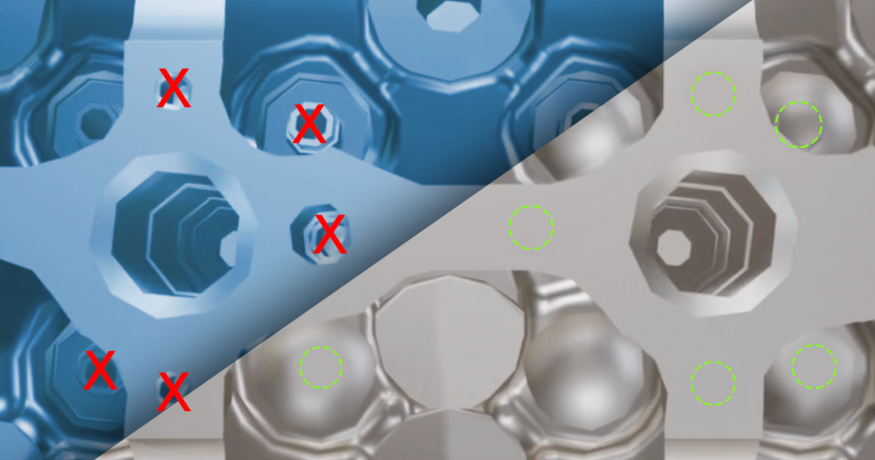Always providing more realism in VR simulation
SkyReal commitment is to replicate the reality as accurate as possible thanks to VR models edited to answer the clients needs. Therefore, the challenge is to adapt a reality, to transcribe it as accurately as possible, regardless of the machine model or the technology on which the VR simulation will be deployed.
This strategy that SkyReal has set itself is based on the fact that its own customers express different needs and levels of requirements to which it is necessary to provide personalized answers. It is also an objective for SkyReal to provide the commitment of VR, namely being able to bring user in environment the more realistic possible.
Facing financial constraints, some companies cannot consider having access to complex VR simulation which require often an important computing power.
Simplification & defeaturing are two process that allow a VR simulation to work on machines equipped with modest configurations.
Simplification & defeaturing implementation: why?
Simplification and defeaturing are two VR approaches aiming the reduction of a CAD file. The idea is to facilitate and accelerate the display of the file in a VR simulation without having an extremely powerful equipment. In this way, SkyReal has developed its own solution tool, SkyPrep, which allows simplification and defeaturing regarding each client need or case.
Offering the more convincing “reality” to the client is still the main objective. Simplification and defeaturing are two ways to achieve the goal but not a purpose in the VR creation.
During a project not all the participants will have to use every datas of the simulation, that all together often represent an important weight very slow to load and to display. Most of the time the participant will only need one part of the simulation. The logic will be to divide the project in different pieces. However, in practice the user has evolved and now want most of the time to work on the whole project, not a piece of it ; hence the necessity regarding those technical and financial constraints to seek the simplification of a VR simulation.
As the practices in industry have evolved, that tendency comes from the wish that different sectors work together on the same project in a collaborative approach, like in VR collaboration way.
Simplification
Simplification is a process to reduce the data volume of a geometry to diminish the weight and the size of a CAD file. The number of information will be divided per two, degrading the precision of the file and so the perceived quality of the object. Therefore, the more the user will be close to a 3D modelize object the more he will see its imperfections.
However, if the total weight of the simulation is important, the degrading of the files will be justified if the display of the simulation is possible on every kind of equipment whatever its complexity.
In the astronautics field for instance, the replication of a rocket will be complex and will need a high level of precision because of the large number of its components. But the actual graphics cards are not enough powerful to work on a large amount of datas to transcribe them in virtual reality. Except the possibility the user have to work with high technology equipment. Typically, the simplification is the answer to that problematic.
Defeaturing
Before explaining what defeaturing is for SkyReal, it should be known that a feature is considered as a component, an element belonging to a set. It could be related for example to the world of hardware and its various elements (nut, bolt, screw, etc.). In this case, the feature would consist of a set of cylinders nested within each other, provided with a circular base, just like a screw.
On a technical drawing we can identify an object, understand its geometric form, its dimensions without knowing how it is assembled. Therefore the hardware mustn’t appeared on the drawing because that object or feature doesn’t change the geometric form. It only serves the assembly of the object.
This shows that these features (or objects) do not have a functional role, or at least that their role differs from the functional role of the main object to which they belong (to hold parts together to constitute a object).
An analogy could be made with the link of a bicycle chain or the wheel of a computer mouse. Ultimately these features can, in some cases, be removed from the simulation (or defeatured) without impacting the utility and drastically reducing the weight of the simulation.
Defeaturing therefore corresponds to the principle of removing a feature that can be full or hollow, such as the screws and their holes. That removal provides a simplified version of the CAD file, making it lighter and easier to display on any equipment or computer.
Furthermore, the difference between the two techniques is that defeaturing relies on topology (geometry of situations) while simplification doesn’t. Topology keeps a set of information on the initial datas and then optimize a geometry making it simpler and displaying it faster.
Simplify the VR approach and adapt solution to the client requests
The next developments for SkyReal in terms of Simplification, answering the clients problematics by improving the process to avoid the need of displaying useless elements within a VR simulation.
That objective answer a client perception that it is not necessary to have a powerful equipment to operate a VR solution. But, displaying a quality VR simulation still require having important IT resources, particularly in an industrial context because of the high complexity of the files.
VR editors must therefore adapt by offering solutions capable of rendering and displaying increasingly large files in a VR simulation, on all types of machines.
Indeed, it seems logical to not display the screws that assembles the fuselage or the wings, as long as it is not necessary for the user or as long as he is not at a certain distance of the plane.



